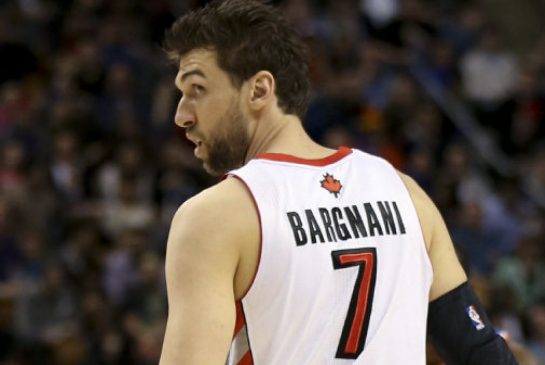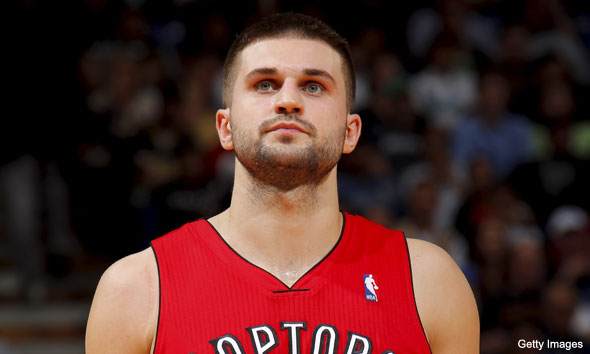With the 2013 offseason in full swing, the Toronto Raptors are at an interesting crossroads.
New general manager Masai Ujiri has replaced Bryan Colangelo. Consequently, the former Denver Nuggets headman inherited Colangelo’s roster and coaching staff.
It stood to reason he might want to make some changes on both fronts. And boy did he. The new headman in Toronto reportedly traded away Andrea Bargnani to the New York Knicks in exchange for Marcus Camby, Quentin Richardson, Steve Novak, a first round pick and two second round picks.
The transaction slightly alters Toronto’s player salary structure.
The Raptors have numerous players signed to big money contracts. For instance, Rudy Gay will make $17.8 million in 2013-14 and DeMar DeRozan will make $9.5 million during that same season.
Those two cap figures are part of the reason the Raptors are going to be over the salary cap in 2013-14 based on their player salaries. Potentially, Ujiri could dispose of Kyle Lowry’s non-guaranteed contract for 2013-14.
Toronto could have stood pat and comfortably headed into the next season with the same roster but management clearly had other ideas in mind.
The biggest obstacle that stood in the way of the Raptors maintaining the status quo: The punitive nature of the tax penalties going into 2013-14.
In addition, one had to question the franchise’s willingness to pay such hefty sums for a team that might miss the postseason once again. Indeed, with Gay in a Raptors uniform, Toronto was a .500 team in 2012-13 (oddly enough, when projected over a full 82-game schedule, that would have gotten the Raps into the postseason dance).
If we look a little towards the future, the Raptors should have a bit of cap room in the 2014 offseason.
Potentially, the Raptors can add a solid player or perhaps two rotation guys when the calendar flips over to July 2014. But between now and then, Toronto will have to work through trades if they are going to bring in talent. Also, if they wish to additionally reduce payroll, swapping players is an option but so is using the amnesty provision.
Our very own Garrett Hinchey did a good job of chronicling the challenges involved with using it on one of the players on the team. Its use will however trim the bill and help secure cap space.
It’s worth noting that the front office has decisions as far as the direction to take moving forward.
As Zach Lowe pointed out at Grantland, teams with poor records in 2012-13 might want to be bad in 2013-14 with scouts projecting a loaded 2014 NBA Draft. Then again, the new general manager might have other things in mind.
Indeed, it’s entirely possible that Ujiri might want to construct a playoff team. If such is the case, he will have to make a few moves to accomplish this. Again, he has no allegiances as far as players are concerned. Thus, everyone could potentially be on the trading block.
The domino most were expecting to fall was Bargnani and he has been jettisoned. His production simply did not match his salary and consequently he was the most obvious player Raptors fans wanted gone.
For those wondering if the Raps could have obtained more for Bargs, he was not an attractive asset. Bargnani is a stretch big man that does not stretch the floor. Have a look at his spot up 3-point percentages in his most recent seasons per Synergy Sports:
| Season | Spot-up 3PT FG% |
|---|---|
| 2010-11 | .336 |
| 2011-12 | .289 |
| 2012-13 | .306 |
Just so we’re clear, spot up jumpers are typically open ones. A stretch big making less than a third of his open treys is not a great shooter at all. For the sake of context, Ryan Anderson and Dirk Nowitzki — big guys that actually stretch the floor — converted north of 38 percent of their spot up shots from long-range in 2012-13.
Now that Bargnani is gone, Toronto must look at other moves if they wish to acquire talent.
The Philadelphia 76ers traded Jrue Holiday to the New Orleans Pelicans for Nerlens Noel. The swap is a direct indication that Philly is comfortable with being bad.
This allows them to clear up some cap space, develop younger players and acquire future players via the draft. The 76ers are going to tank, but perhaps they could use a veteran big man to assist in mentoring Noel.
Toronto can opt for a high risk and high reward transaction: a sign-and-trade for the services of Andrew Bynum.
The collective bargaining agreement states that a team cannot receive a player in a sign-and-trade if by the conclusion of the transaction they are above the tap apron ($4 million over the tax level). The Raptors are currently over the salary cap, but are not yet as of yet projected to be a luxury tax team.
Thus, swapping Camby and filler for Bynum in a sign-and-trade works if his contract is in the $7 million per year range. Bynum’s deal would be a two-year contract with a team option for the second season. Toronto could acquire him in this move within the confines of the CBA. Whether or not Bynum’s injury has lowered his value that far is unlikely, but other assets could be added to make the math work.
If Bynum can suit up for north of 50 games, the Raptors are quite possibly a playoff team. If he misses most of the season, Toronto can change course and tank midway through the season and end up with a lottery pick.
The Bargnani transaction coupled with Toronto’s reported interest in Eric Bledsoe suggest Ujiri is looking to make deals and change the roster. In the event the Raps pull off the rumored Bledsoe swap, it changes the team’s direction. There is potential for salary cap relief depending on whom the Raps would take back from the Los Angeles Clippers.
No matter how we look at things, it certainly seems as though the time for the Raptors to improve their outlook is now. Raptors fans might be happy to know that Ujiri is clearly aware of this.



